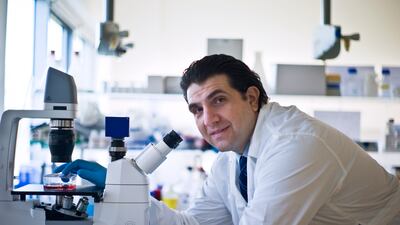ABU DHABI // A scientist has reprogrammed skin cells so that they start behaving like heart muscle cells, in a breakthrough that could prove of great value in medicine.
The work by Dr Nicolas Christoforou, carried out while he was an assistant professor at Khalifa University in Abu Dhabi, comes amid much interest among researchers across the world in finding ways to produce cardiac tissue in the laboratory.
Scientists are keen to find ways of generating material that could be used to repair hearts that have suffered damage during heart attacks.
Three in every 10 deaths in the UAE are due to heart disease, and doctors here have seen patients as young as 28 have heart attacks, with risk of heart disease starting 10 years earlier here than in western countries.
“We believe that this project is extremely significant both for basic science as well as for future therapeutic applications,” said Dr Christoforou.
In a highly complex set of procedures, the researchers started off with human dermal fibroblast cells, a type of cell found in human skin that produces connective tissue, often in response to injury.
To reprogramme these cells they added small sections of genetic material called micro RNAs and a number of transcription factors, which are proteins that cause particular genes to be activated.
The cells were also manipulated in other ways, and the result was that many of them started to behave like heart muscle cells, expressing the same genes cells and having the same biochemical processes activated.
Dr Christoforou said the key achievement of the study was to identify what conditions are needed, particularly in terms of which substances must be added, to make the dermal fibroblast cells undergo this change. This reprogramming of one cell type into another is known as transdifferentiation.
“We were extremely pleased to be able to define and report these parameters,” he said.
Although conversion into cardiomyocytes did not happen with all cells, a similar approach could ultimately mean that scientists could generate large numbers of human cardiomyocytes in the laboratory, and these could help in the regeneration of damaged heart muscle. Other scientists have found that injecting monkeys with heart cells made outside the body helps the organ to repair itself and to pump blood more effectively.
“I feel that the field of transdifferentiation is in its infancy and will expand significantly over the next few years,” said Dr Christoforou.
He said there was currently a particular focus for the production of neurons or nerve cells, but that “an increasing number of reports” are looking, like this recent study, at transdifferentiation into other types of cells.
“The impact of this approach in medical applications is huge as it would allow the formation of cells in situ [in the laboratory] in an efficient manner,” he said.
The work was published in the journal Scientific Reports.
Dr Christoforou, who recently left Khalifa University after a five-year stint there and is now principal scientist for a North Carolina-based company called Humacyte that produces human tissue replacements, is the joint senior author of the work, which was written with five other researchers, all based in the United States.
Although the findings have been published only recently, work on the project dates back about four years and built upon previous research by Dr Christoforou and his co-authors.
The importance of being able to reprogramme cells was reflected in the awarding, in 2012, of the Nobel Prize in Physiology or Medicine to two scientists, Sir John Gurdon and Shinya Yamanaka, who showed how mature cells could be reprogrammed to become stem cells, which can then be turned into other types of cell.
The method used in Dr Christoforou’s is different in that it does not involve turning mature cells into stem cells; instead it involves a change from one type of mature cell to another. However, as reported in The National in 2015, Dr Christoforou carried out other work at Khalifa University that has involved reprogramming specialised cells so that they become induced pluripotent stem cells, which can be turned into other cell types.


